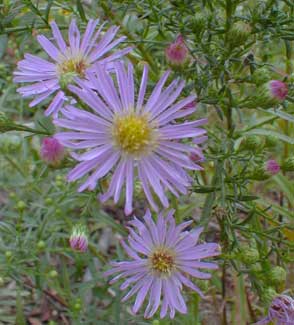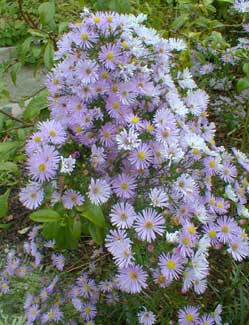
'Pink Star'
Heath Aster or Farewell-to-Summer
So all day long I followed through the fields
The voice of Autumn, calling from afar;
And now I thought: "Yon hazel thicket yields
A glimpse of her," & now: "These asters are
Sure sign that she of late has passed this way."
-Elizabeth Green Crane,
circa 1900
circa 1900
 Aster ericoides (synonymous with Symphyotrichum ericoides) is variously known as Heath Aster, Prairie Aster, Wreath Aster, Squarose Aster, Elongate Aster, Dense-Flowered Aster, or Tufted Aster.
Aster ericoides (synonymous with Symphyotrichum ericoides) is variously known as Heath Aster, Prairie Aster, Wreath Aster, Squarose Aster, Elongate Aster, Dense-Flowered Aster, or Tufted Aster.Because it can be the very last meadow wildflower to bloom each year it is called Farewell-to-Summer. In ideal conditions to its liking it can take over a meadow displacing other plants, thus it has been called most critically Goodbye-to-Meadow. It is not much liked by cattle, either, so is an unwanted native invader of grazing land.
The primary variants are: A. ericoides forma ericoides which is the common white heath aster, & A. ericoides forma caeruleus with lilac flowers, the latter producing such pink-violet strains as 'Pink Star.' There is also a natural creeping form, A. ericoides forma prostratus.
Besides intraspecies hybrids, this variable species also crosses freely with A. falcatus, A. commutatus, & A. pansus, so that there is great potential for an increasing range of selected strains & hybrid cultivars.
Despite the name 'Pink Star,' to me the color looks much closer to pale violet. And though the species is native to the eastern United States, this select strain was developed in Holland.
It is a rugged heat-hardy & cold-hardy perennial aster that grows to around two feet of height & will clump over time to two or three feet wide, spreading by stolons. It can become weedy in some zones but is usually restrained here in the damp Northwest.
It ranges from Saskatchawan & Maine to Virginia, to the Great Lakes region, the Dakotas, Nebraska & the Great Plains through Texas & Arizona into northern Mexico. It is adapted to seasonal wetness & dryness as experienced in many prairies, & is adaptable in the garden in zones five through eight.
Native Americans used heath asters in their steam lodges, laying branches on the hot rocks to create herbal steam. It is a butterfly attractant, & is deer resistant.
Its leaves are small & thin, airy in appearance, its three-quarter-inch daisy-blooms being numerous & showy in late summer & early autumn. It can bloom from August to as late as early November, but its main flowering occurrs for us in September & October.